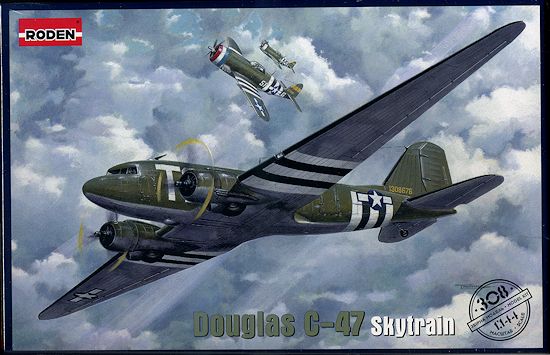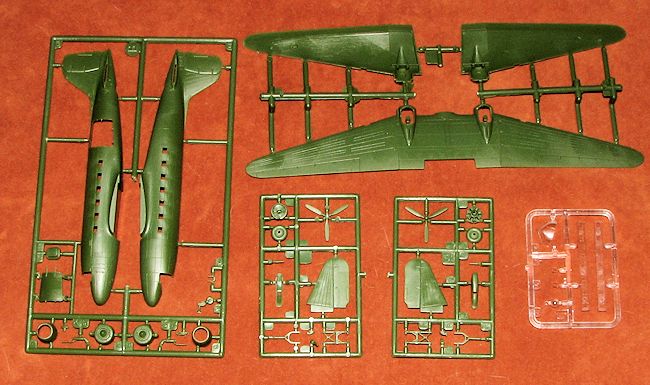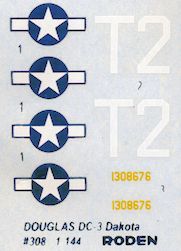
Roden 1/144 C-47 Skytrain
| KIT #: | 308 |
| PRICE: | $24.99 MSRP |
| DECALS: | Two options |
| REVIEWER: | Scott Van Aken |
| NOTES: | New tool kit |

| HISTORY |
The C-47 was vital to the success of many Allied campaigns, in particular those at Guadalcanal and in the jungles of New Guinea and Burma where the C-47 (and its naval version, the R4D) made it possible for Allied troops to counter the mobility of the light-traveling Japanese army. Additionally, C-47s were used to airlift supplies to the embattled American forces during the Battle of Bastogne. Possibly its most influential role in military aviation, however, was flying "The Hump" from India into China. The expertise gained flying "The Hump" was later be used in the Berlin Airlift, in which the C-47 played a major role, until the aircraft were replaced by Douglas C-54 Skymasters.
In Europe, the C-47 and a specialized paratroop variant, the C-53 Skytrooper, were used in vast numbers in the later stages of the war, particularly to tow gliders and drop paratroops. In the Pacific, with careful use of the island landing strips of the Pacific Ocean, C-47s were even used for ferrying soldiers serving in the Pacific theater back to the United States.
C-47s (approx. 2,000 received under lend-lease) in British and Commonwealth service took the name Dakota, from the acronym "DACoTA" for Douglas Aircraft Company Transport Aircraft. The C-47 also earned the informal nickname Gooney Bird in the European theater of operations.
Other sources (C-47/R4D Skytrain Units of the Pacific and CBI, David Isby, Osprey Combat Aircraft #66, Osprey Publishing Limited, 2007) attribute this name to the first plane, a USMC R2D - the military version of the DC-2 - being the first plane to land on Midway Island, previously home to the native long-winged albatross known as the Gooney Bird which was native to Midway.
The United States Air Force's Strategic Air Command had Skytrains in service from 1946 through 1967.
With all of the aircraft and pilots having been part of the Indian Air Force prior to Independence, both the Indian Air Force and Pakistan Air Force used C-47s to transport supplies to their soldiers fighting in the Indo-Pakistan War of 1947.
Several C-47 variations were used in the Vietnam War by the United States Air Force, including three advanced electronic warfare variations, which sometimes were called "Electric Gooneys" designated EC-47N, EC-47P, or EC-47Qs depending on the engine used. EC-47s were also operated by the Vietnamese, Laotian and Cambodian Air Forces. A gunship variation, using three 7.62mm miniguns, designated AC-47 "Spooky" often nicknamed "Puff the Magic Dragon" also was deployed.
The Royal Canadian Air Force and later, the Canadian Armed Forces employed the C-47 for transportation, navigation, and radar training, as well as for search and rescue operations from the 1940s to the 1980s.
After World War II thousands of surplus C-47s were converted to civil airline use, some remaining in operation in 2012 as well as being used as private aircraft.
| THE KIT |
 This is not the
first time that the C-47 has been kitted in this scale. Minicraft, among perhaps
others, has had one out for many years, but there were comments on how it could
have been a better kit. I'll leave it to those who know more than I to come up
with what wasn't right with it.
This is not the
first time that the C-47 has been kitted in this scale. Minicraft, among perhaps
others, has had one out for many years, but there were comments on how it could
have been a better kit. I'll leave it to those who know more than I to come up
with what wasn't right with it.
Roden's kit is a brand new tooling and has sharp, engraved panel lines. The four olive green and single clear sprue are nicely detailed and though I did note a tad bit of flash in places, it is something I have come to expect from Roden, even on new kits. The clear windows insert from the inside and judging by the need to trim a window from the cargo door side, I am thinking that there will be a civil DC-3 version coming along soon. In fact, I expect a bunch of different boxings.
There is no cockpit at all, which will disappoint some. The
windscreen section is molded in with part of the upper fuselage, a feature many
like. The engine in nicely detailed as is the landing gear, which looks properly
done. Wheels and stabilizers are a single piece with the tail wheel molded in
with the strut. Props look to be the correct type for the C-47. There are
antennas an an astrodome for the roof and holes need to be opened or drilled for
these items. I should add that the kit comes with a complete tail cone,
something not always found on wartime C-47s. The main instructions embarrasingly
miss the instalation of the long upper cowling carb intakes, but this is taken
care of by an addendum page. It appears that the short
 intakes are
also included but not used.
intakes are
also included but not used.
Instructions are fairly well done with all of the color information noted on the back of the instructions. Vallejo paints are the main reference, but the colors are quite common in most paint lines. The lone markings option is with the "53rd Wing, 101st Airborne Division". OK. It is a D-Day marked plane with only the nose number and serial to differentiate it from other C-47s. The white and black bands will need to be painted on which, considering the reputation of Roden decals, may well be a good thing. I know that I would have liked several options, but this will be a good opportunity for the aftermarket folks to step up to the plate for us.
| CONCLUSIONS |
I know that this will be well received. The C-47 is a favorite among modelers of all types and rare is it that a collection does not have at least one.
| REFERENCES |
http://en.wikipedia.org/wiki/C-47_Skytrain
April 2013
Thanks to Squadron Products for the preview kit. Get yours today at your local hobby shop or on-line retailer.
If you would like your product reviewed fairly and fairly quickly, please contact the editor or see other details in the Note to Contributors.